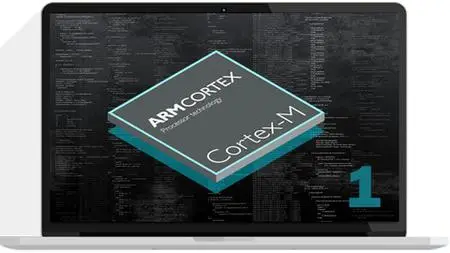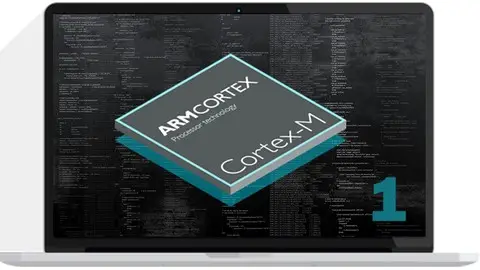Arm Assembly Language From Ground Up™ 1
Last updated 2/2022
MP4 | Video: h264, 1280x720 | Audio: AAC, 44.1 KHz
Language: English | Size: 7.85 GB | Duration: 15h 7m
Last updated 2/2022
MP4 | Video: h264, 1280x720 | Audio: AAC, 44.1 KHz
Language: English | Size: 7.85 GB | Duration: 15h 7m
Build over 50 Assembly Programs - ARM Instruction Set, Peripheral Driver Development, Algorithms, DSP routines etc.
What you'll learn
Master the ARM Instruction Set
Master the Thumb and Thumb-2 Instruction Sets
Understand the ARM Design Philosophy
Understand RISC Architecture
Master creating Data Structures in Assembly
Master creating State Machines in Assembly
Master building complex Algorithms in Assembly
Master writing hardware Drivers in Assembly
Be able to create Lookup Tables and Jump Tables in Assembly
Be able to understand and apply the IEEE- 754 Floating point standard
Requirements
No programming experience needed - I'll teach you everything you need to know
No paid software required - all assembly programs will be created in Keil uVision 5 (which is free)
I'll walk you through, step-by-step how download and install Keil uVision
You will need an STM32F4-DISCOVERY board for some of the practical lessons.
Description
Welcome to the ARM Assembly Programming From Ground Up™ 1 course. Covering ARM Systems Design, Architecture and Practical Assembly Programming, this is the most comprehensive ARM assembly course online.I'll take you step-by-step through engaging and fun video tutorials and teach you everything you need to know to succeed as an ARM embedded developer.This course comes in two parts. This is the first part of the course.By the end of this part you will master the ARM Instruction Set, the Thumb Instruction Set and the Thumb-2 Instruction Set. You will be able to create data structures such as FIFOs and LIFOs in Assembly. You will also be able to create Finite State Machines such as the Moore Machine and Mealy Machine. Furthermore you will design complex algorithms for performing Binary Search in assembly , and solving advance mathematical problems like the Taylor Series and the Bisection Algorithm . REMEMBER : I have no doubt you will love this course. Also it comes with a FULL money back guarantee for 30 days! So put simply, you really have nothing to loose and everything to gain. Sign up and lets start writing some low level code.
Overview
Section 1: Introduction
Lecture 1 Introduction
Lecture 2 Dev Board
Lecture 3 Set up
Section 2: Introduction to ARM Assembly Language
Lecture 4 The Computing Device
Lecture 5 Number Systems
Lecture 6 Assembly Tools
Lecture 7 Translating Bits to Commands
Lecture 8 Assembly Syntax
Section 3: ARM Design Philosophy and RISC Architecture
Lecture 9 The RISC Design Philosophy
Lecture 10 The ARM Design Philosophy
Lecture 11 Embedded Systems with ARM Processors
Lecture 12 ARM Bus Technology and AMBA Bus Protocol
Lecture 13 Memory
Lecture 14 Peripherals
Lecture 15 Von Nuemann and Harvard architecture
Lecture 16 Cache and Tightly Couple Memory
Lecture 17 Memory Management extensions
Lecture 18 Co-processor extensions
Section 4: The Programmer's Model
Lecture 19 Data Types
Lecture 20 Processor Modes
Lecture 21 ARM7TDMI Registers
Lecture 22 ARM7TDMI Vector Table
Lecture 23 ARM Cortex-M Registers
Lecture 24 ARM Cortex-M Vector Table
Lecture 25 ARM Data Flow Model
Lecture 26 The Pipeline
Lecture 27 ARM Processor Family
Lecture 28 ARM Cortex-A and Cortex-R
Lecture 29 ARM Cortex-M
Lecture 30 Section Summary
Section 5: Assembler Rules and Directives
Lecture 31 Structure of an Assembly Module
Lecture 32 The ARM,Thumb and Thumb-2 Instruction Sets
Lecture 33 Predefined Register Names
Lecture 34 Frequently used Directives
Lecture 35 Coding : Simple Assembly Project with Startup File
Lecture 36 Coding : Importance of the Reset_Handler
Lecture 37 Coding : Simple Assembly Project without Startup File
Lecture 38 Coding : Allocating space in memory with the SPACE Directive
Lecture 39 Overview of Binary Operators
Lecture 40 Coding : Swapping Register Content
Lecture 41 Coding : Renaming Registers
Section 6: Load-Store Instructions
Lecture 42 Memory Demarcations
Lecture 43 Frequently used Load/Store Instructions (Part I)
Lecture 44 Frequently used Load/Store Instructions (Part II)
Lecture 45 Frequently used Load/Store Instructions (Part III)
Lecture 46 Resource Download
Lecture 47 Pre-Indexed Addressing
Lecture 48 Post-Indexed Addressing
Lecture 49 Endianness
Lecture 50 Defining Memory Areas
Lecture 51 Coding : Copying Data from One Memory Location to Another
Section 7: Dealing with Constants and Literals
Lecture 52 The Encoding of the MOV Instruction
Lecture 53 The ARM Rotation Scheme
Lecture 54 Loading Constants with the LDR Instruction
Lecture 55 Loading Constants with the MOVW and MOVT Instructions
Lecture 56 Loading Labels with ADR, ADRL and LDR Instructions
Lecture 57 Coding : Solving a Simple Equation Method 1
Lecture 58 Coding : Solving a Simple Equation Method 2 - Storing Constants in Memory
Lecture 59 Coding : Solving a Simple Equation Method 3 - Using Register Relative Addressing
Lecture 60 Coding : Solving a Simple Equation Method 4 - Compact Code
Section 8: Arithmetic and Logic Instructions
Lecture 61 Flags
Lecture 62 The N and V Flags
Lecture 63 The Z and C Flags
Lecture 64 Compare/Test Instructions
Lecture 65 Overview of Boolean Operations
Lecture 66 Coding : Experimenting with the PSR Flags
Lecture 67 Coding : Experimenting with the Carry Flag
Lecture 68 Coding : Experimenting with the Overflow Bit
Lecture 69 Introduction to Shifts and Rotations
Lecture 70 Understanding Logical Shifts
Lecture 71 Understanding Rotations
Lecture 72 Some Shift and Rotate Examples
Lecture 73 Coding : Experimenting with the Logical Shift Left Instruction
Lecture 74 Overview Addition and Subtraction Instructions
Lecture 75 Coding : Finding the Maximum Value in a Dataset
Lecture 76 Coding : Adding Signed Data
Lecture 77 Coding : Finding the Minimum Signed Data
Lecture 78 Overview of Saturated Math Instructions
Lecture 79 Overview of Multiplication Instructions
Lecture 80 Multiplying by Constants
Lecture 81 Coding : Solving a More Complex Equation
Lecture 82 Overview of the Division Instruction
Lecture 83 Coding : Performing Division by Subtraction
Lecture 84 Overview of DSP Instructions
Lecture 85 Fractional Notation
Lecture 86 Bit Manipulation Instructions
Lecture 87 Understanding Q Notation
Section 9: Branch and Loop Instructions
Lecture 88 Introduction to Branches and Loops
Lecture 89 Branching
Lecture 90 Compare and Branch
Lecture 91 Loops in Assembly
Lecture 92 Conditional Execution
Lecture 93 The IF-THEN Block
Lecture 94 Coding : Computing the Factorial of a Number using the IF-THEN Block
Section 10: Tables
Lecture 95 Introduction to Tables
Lecture 96 Navigating a Lookup Table
Lecture 97 Coding : Constructing a Floating-Point Lookup Table
Lecture 98 Coding : Constructing a Floating-Point Lookup Table - Version 2
Lecture 99 Coding : Creating a Program to Rapidly Compute the Sine of a Value (Part I)
Lecture 100 Creating a Program to Rapidly Compute the Sine of a Value (Part II)
Lecture 101 Coding : Creating a Program to Rapidly Compute the Sine of a Value (Part III)
Lecture 102 Coding : Creating Jump Tables
Section 11: Stack Instructions
Lecture 103 Introduction to the Stack
Lecture 104 The LDM and STM Instructions
Lecture 105 Syntax of the PUSH and POP Instructions
Lecture 106 Coding : Creating a Simple Stack
Lecture 107 Coding : Saving and Restoring Context
Section 12: The Floating Point Unit
Lecture 108 Contributions of a Floating Point Unit with to an Embedded Processor
Lecture 109 Floating-Point Data Types
Lecture 110 Syntax of Floating-Point Instructions
Lecture 111 Overview of Floating Point Instructions
Lecture 112 Coding : Enabling the Floating-Point Coprocessor
Lecture 113 Coding : Transferring Data Between Main Registers and Floating-Point Registers
Section 13: Mixing C and Assembly
Lecture 114 Coding : Inline Assembly
Lecture 115 Coding : Exporting a Subroutine from Assembly to C
Lecture 116 Coding : Exporting a Function from C to Assembly
Section 14: Peripheral Drivers Development (STM32F411- DISCOVERY BOARD )
Lecture 117 Coding : STM32F4 GPIO Driver Development ( Part I)
Lecture 118 Coding : STM32F4 GPIO Driver Development ( Part II )
Lecture 119 Coding : STM32F4 GPIO Driver Development ( Part III )
Lecture 120 Coding : STM32F4 GPIO Driver Development ( Part IV)
Section 15: Peripheral Drivers Development (STM32-F411- NUCLEO BOARD )
Lecture 121 Coding : Assigning Symbolic Names to Relevant GPIO Registers
Lecture 122 Coding : Writing the GPIO Output Driver
Lecture 123 Coding : Toggling GPIO Outputs
Lecture 124 Coding : Toggling GPIO Outputs with the BSRR Register
Section 16: Peripheral Drivers Development ( TM4C123- TIVA C BOARD )
Lecture 125 Coding : Assigning Symbolic Names to Relevant GPIO Registers
Lecture 126 Coding : Implementing the GPIO Output Driver
Lecture 127 Coding : Assigning Symbolic Names to Relevant GPIO Input Registers
Lecture 128 Coding : Implementing the GPIO Input Driver
Lecture 129 Coding : Toggling GPIO Outputs
Section 17: Data Structures
Lecture 130 Introduction to FIFOs
Lecture 131 Coding : Fifo Implementation (Part I)
Lecture 132 Coding : Fifo Implementation (Part II)
Lecture 133 Coding : Fifo Implementation (Part III)
Section 18: Algorithms Developments
Lecture 134 Coding : Developing the Recursive Factorial Algorithm (Part I)
Lecture 135 Coding : Developing the Recursive Factorial Algorithm (Part II)
Lecture 136 Taylor Series Expansion algorithm (Part I)
Lecture 137 Coding : Taylor Series Expansion algorithm (Part II)
Lecture 138 Overview of The Reciprocal Square Root Algorithm
Lecture 139 Coding : The Reciprocal Square Root Estimate Algorithm (Part I)
Lecture 140 Coding : The Reciprocal Square Root Estimate Algorithm (Part II)
Lecture 141 Overview of the Bisection algorithm
Section 19: Finite State Machines
Lecture 142 Introduction to Finite State Machines
Lecture 143 Understanding the Moore's Finite State Machine
Lecture 144 Implementation of the Moore's FSM
Section 20: Set up - Keil uVision 5
Lecture 145 Downloading Keil uVision 5
Lecture 146 Installing Keil uVision 5
Lecture 147 Installing Packs
Lecture 148 Overview of Keil uVision
Lecture 149 Changing the Compiler
Section 21: Closing
Lecture 150 Closing Remarks
If you are an absolute beginner to embedded programming, then take this course.,If you are a seasoned programmer, then take this course to to get up to speed with ARM architecture and assembly programming,If you are switching from other architectures such x86 to ARM then this is a fast-track way of doing it. You can get started straight away with the ARM Instruction Set.



